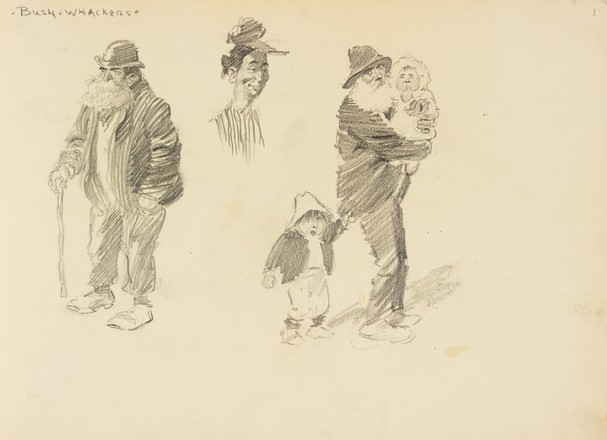Portrait studies
c1901
Graphite on paper
Bequest of Sir William Dixson, 1952
DL PX 69
Norman Lindsay worked in a variety of mediums, including oils, watercolour, pen, etching and drypoint. Yet pencil was the only one he continued to work in throughout his life. His first works were childhood drawings of family pets and backyard scenes. His last sketches were of the nurses who cared for him in hospital just prior to his death.
As a child, Lindsay had suffered from a blood disorder which prevented him from strenuous exercise and active outdoor play, but instilled in him great skills of observation:
As a small boy, I practised observation, consciously memorizing forms. My system was to study the form of a fowl, a duck, a cat, a dog, or any other specimen of livestock in our backyard, and then run inside and jot down the image of it before it faded from the mental retina.*
While at school, Norman Lindsay
would spend time drawing the faces of girls: ‘Another diversion which pleased
me greatly was the drawing of girls’ heads on small circular pieces of paper to
fit inside my watch case. If I chanced to get a reasonable likeness to the girl
who engaged my amorous meditations, thereafter I found a lyrical thrill in
pulling out my watch and glancing not at the time, but at the girl’s image’.*
Footnotes
* Norman
Lindsay, My Mask: For what Little I Know
of the Man Behind it: an Autobiography, 1970, p 62
Norman Lindsay moved to Faulconbridge
in the Blue Mountains in 1912 and lived there on and off until his death. Towards
the end of 1969 he was hospitalised, but continued drawing, producing pencil
sketches of the nurses right up until his death on 21 November 1969.
Throughout World War I
Norman Lindsay’s political views aligned closely with the nationalistic and
patriotic policies of the Bulletin. His cartoons were highly partisan,
depicting Germans as monsters slaying the innocent. He also produced artwork
for a number of government recruitment posters.
The Bulletin stopped publication in January 2008, after 128 years.
All through his life, Norman Lindsay was very
frugal with paper: ‘Anything with a blank surface was collected
and he and his brothers used to go to the local draper’s for shoe boxes and
cartons to use for drawings’.*
Footnotes
*Jane Lindsay, Portrait of Pa: Norman Lindsay at Springwood,
1973, p 13



 Back to list
Back to list